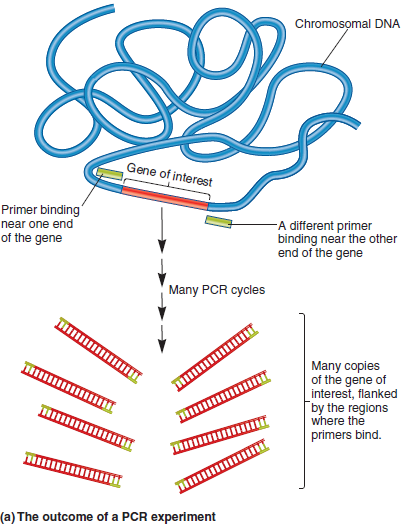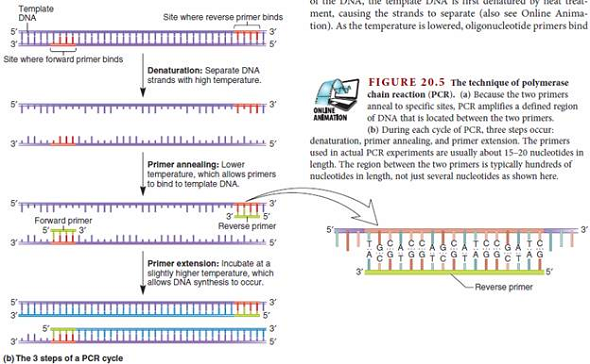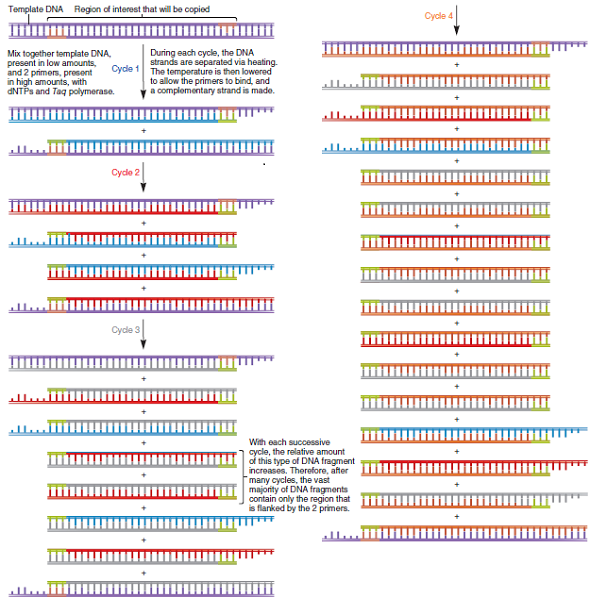
Genetics: Analysis and Principles 5th Edition by Robert Brooker
Edition 5ISBN: 978-0073525341
Genetics: Analysis and Principles 5th Edition by Robert Brooker
Edition 5ISBN: 978-0073525341 Exercise 25
Another technique described in Chapter 20 is polymerase chain reaction (PCR) (see Figures 20.5 and 20.6). This method is based on our understanding of DNA replication. In this method, a small amount of double-stranded template DNA is mixed with a high concentration of primers. Nucleotides and DNA polymerase are also added. The template DNA strands are separated by heat treatment, and when the temperature is lowered, the primers bind to the single-stranded DNA, and then DNA polymerase replicates the DNA. This increases the amount of DNA made from the primers. This cycle of steps (i.e., heat treatment, lower temperature, allowing DNA replication to occur) is repeated again and again. Because the cycles are repeated many times, this method is called a chain reaction. It is called polymerase chain reaction because DNA polymerase is the enzyme needed to increase the amount of DNA with each cycle. In a PCR experiment, the template DNA is placed in a tube, and the primers, nucleotides, and DNA polymerase are added to the tube. The tube is then placed in a machine called a thermocycler, which raises and lowers the temperature. During one cycle, the temperature is raised (e.g., to 95°C) for a brief period and then lowered (e.g., to 60°C) to allow the primers to bind. The sample is then incubated at a slightly higher temperature for a few minutes to allow DNA replication to proceed. In a typical PCR experiment, the tube may be left in the thermocycler for 25-30 cycles. The total time for a PCR experiment is a few hours
a. Why is DNA helicase not needed in a PCR experiment
B. How is the sequence of each primer important in a PCR experiment Do the two primers recognize the same strand or opposite strands
C. The DNA polymerase used in PCR experiments is a DNA polymerase isolated from thermophilic bacteria. Why is this kind of polymerase used
D. If a tube initially contained 10 copies of double-stranded DNA, how many copies of double-stranded DNA (in the region flanked by the two primers) would be obtained after 27 cycles
FIGURE 20.5 The technique of polymerase chain reaction (PCR). (a) Because the two primers anneal to specific sites, PCR amplifies a defined region of DNA that is located between the two primers. (b) During each cycle of PCR, three steps occur: denaturation, primer annealing, and primer extension. The primers used in actual PCR experiments are usually about 15-20 nucleotides in length. The region between the two primers is typically hundreds of nucleotides in length, not just several nucleotides as shown here.

a.
FIGURE 20.6 The technique of PCR carried out for four cycles. During each cycle, oligonucleotides that are complementary to the ends of the targeted DNA sequence (green) bind to the DNA and act as primers for the synthesis of this DNA region. Note: The original DNA strands are purple, and those strands made during the first, second, third, and fourth cycles are blue, red, gray, and orange, respectively.
a. Why is DNA helicase not needed in a PCR experiment
B. How is the sequence of each primer important in a PCR experiment Do the two primers recognize the same strand or opposite strands
C. The DNA polymerase used in PCR experiments is a DNA polymerase isolated from thermophilic bacteria. Why is this kind of polymerase used
D. If a tube initially contained 10 copies of double-stranded DNA, how many copies of double-stranded DNA (in the region flanked by the two primers) would be obtained after 27 cycles
FIGURE 20.5 The technique of polymerase chain reaction (PCR). (a) Because the two primers anneal to specific sites, PCR amplifies a defined region of DNA that is located between the two primers. (b) During each cycle of PCR, three steps occur: denaturation, primer annealing, and primer extension. The primers used in actual PCR experiments are usually about 15-20 nucleotides in length. The region between the two primers is typically hundreds of nucleotides in length, not just several nucleotides as shown here.


a.
FIGURE 20.6 The technique of PCR carried out for four cycles. During each cycle, oligonucleotides that are complementary to the ends of the targeted DNA sequence (green) bind to the DNA and act as primers for the synthesis of this DNA region. Note: The original DNA strands are purple, and those strands made during the first, second, third, and fourth cycles are blue, red, gray, and orange, respectively.

Explanation
(A)
Helicase is not required since heat ...
Genetics: Analysis and Principles 5th Edition by Robert Brooker
Why don’t you like this exercise?
Other Minimum 8 character and maximum 255 character
Character 255



